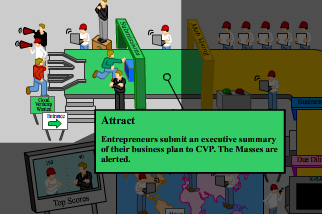In the next series of articles, I will talk about valuation. When you do a financing deal based on equity, you will need to come to a landing on a valuation for your company. This can be hard because there is no exact science to valuing early stage companies. In this article, I will illustrate how investors look at valuation and why it is important in realizing their investment objectives.
First off, most angels aim for a 10x return on their investment. This means if they were to put $100,000 into a company, they would want to exit with $1,000,000. This target is based on a portfolio basis of investing. What this means is that investors aim to mitigate the high risk of early stage companies failing by investing in a portfolio of companies.
If an angel had $1,000,000 to invest and they put it all in one company, they may loose it all or barely get their initial investment back if the company does not take off. Rather than put all eggs in one basket, the portfolio approach would split the $1,000,000 into 10 investments of $100,000 across 10 companies. There are different rules of thumb you can apply but basically the gist is that only a few companies in the portfolio will be very successful that generate multiples of return and these have to subsidize the other companies in the portfolio that provide no return or result in a loss. For example, in a hypothetical portfolio of 10 companies:
3 fail and result in a loss of money
3 break even that may give a small return on initial investment
2 return a 2x return on investment
1 returns a 5x return on investment
1 returns a 10x return on investment
The angel naturally aspires for all company investments to generate a 10x return. However, the reality is that only one will be a home run and it will subsidize investment losses on companies that fail.
In order to see how an investor would realize a 10x return on an investment in a company, lets walk through a very simplified funding example.
Lets say a company has developed a POC and is looking for their first angel around of financing to fund a market launch. The company has 1 million shares outstanding and is priced at $2 per share for a company valuation of $2 million. An angel puts in $200,000 so now the company has 1,100,000 shares outstanding with a post-investment valuation of $2.2 million. The angel owns 100,000 shares.
The company uses this money to launch, gets good traction and now is looking for another round of financing to rapidly expand into new markets. For this round, the valuation is increased by 50% to $3 per share to account for the increase in value of the company given its early market traction. A VC puts in $1,500,000 so now the company has 1,600,000 shares outstanding with a post investment valuation of $4,800,000.
The company makes good progress and gets sales to $10 million. At this point one of their competitors buys the company based on a 3x revenue multiple for a valuation of $32,000,000 or $20.00 per share.
The angel’s exit is 100,000 shares * $20.00= $2,000,000. So the angel basically gets their home run investment or 10x return they are seeking.
Now lets run the same scenario with a different valuation. For the first angel financing, the same company gets priced at $6 per share for a company valuation of $6 million. The angel’s $200,000 investment provides the angel with 33,333 shares. The second round of financing is priced at $9 per share for a valuation of $9,300,000. After the VCs $1,500,000 investment there are 1,200,000 shares outstanding. The company gets to the same revenue of $10 million and is purchased for the same 3x revenue multiple / $32,000,000 valuation. The price per share works out to $26.67 giving the angel an exit of 33,333 shares * $26.67= $888,991. In this example, nothing changed with the company except the initial valuation. However, the angel only realized a 4x return.
This is an overly simplistic example so don’t read too much into the revenue or acquisition pricing numbers. The main point I’m trying to illustrate is that having a high valuation at the start of a company’s financing rounds can limit the investors upside potential. In the second scenario, the acquisition price would have to be more than double to keep the same 10x return as in the first example. So when an investor is confronted with an investment choice between 2 companies, one with a high valuation and one with a more reasonable valuation, the investor will be asking themselves if the more highly valued company is more likely to grow revenues/profits faster and/or be acquired for a larger amount to justify the high valuation. Also keep in mind that large acquisition deals are not as common as smaller acquisition deals. So if an investor is pegging their exit to an acquisition, they also need to factor in the lessened probability due the smaller universe of potential acquirers. These are reasons why investors may turn down investment in a company if the valuation is way off. Even though the company may be very promising and have a lot of strengths, the valuation may not align to the investor’s investment return expectations.
In my next article, I will cover ways to calculate value of a company. To view an organized index of all angel financing articles as well as see a roadmap of future articles, click here. If you have any comments or suggestions for future articles feel free to contact me: craig at mapleleafangels.com
 In case you weren’t already aware, TIE Toronto (an entrepreneur support group in Toronto) is holding TIEQuest.
In case you weren’t already aware, TIE Toronto (an entrepreneur support group in Toronto) is holding TIEQuest.



 I just got word from the guys at
I just got word from the guys at  I dropped
I dropped 
 The Toronto tech and community scenes have exploded over the past couple of years. We often hear about successful entrepreneurs or interesting startups but finding the time to attend all of the events and meet interesting people isn’t easy.
The Toronto tech and community scenes have exploded over the past couple of years. We often hear about successful entrepreneurs or interesting startups but finding the time to attend all of the events and meet interesting people isn’t easy.